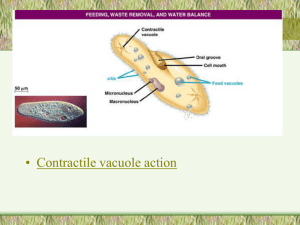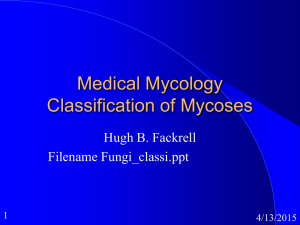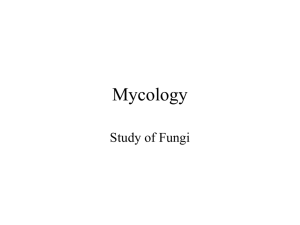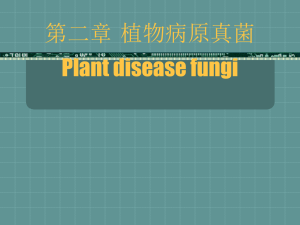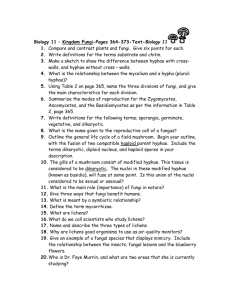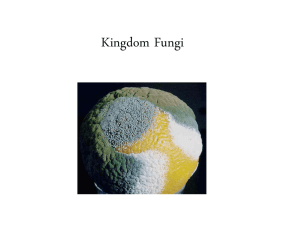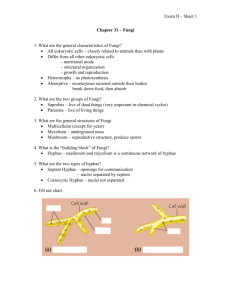File - Microbiology
advertisement
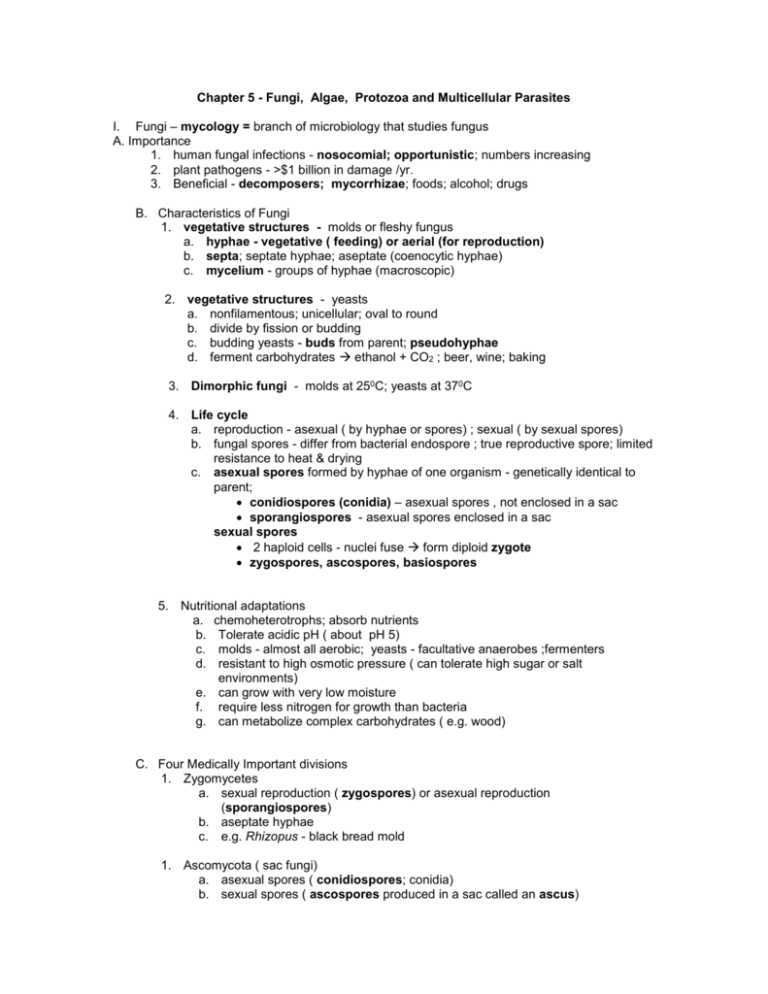
Chapter 5 - Fungi, Algae, Protozoa and Multicellular Parasites I. Fungi – mycology = branch of microbiology that studies fungus A. Importance 1. human fungal infections - nosocomial; opportunistic; numbers increasing 2. plant pathogens - >$1 billion in damage /yr. 3. Beneficial - decomposers; mycorrhizae; foods; alcohol; drugs B. Characteristics of Fungi 1. vegetative structures - molds or fleshy fungus a. hyphae - vegetative ( feeding) or aerial (for reproduction) b. septa; septate hyphae; aseptate (coenocytic hyphae) c. mycelium - groups of hyphae (macroscopic) 2. vegetative structures - yeasts a. nonfilamentous; unicellular; oval to round b. divide by fission or budding c. budding yeasts - buds from parent; pseudohyphae d. ferment carbohydrates ethanol + CO2 ; beer, wine; baking 3. Dimorphic fungi - molds at 250C; yeasts at 370C 4. Life cycle a. reproduction - asexual ( by hyphae or spores) ; sexual ( by sexual spores) b. fungal spores - differ from bacterial endospore ; true reproductive spore; limited resistance to heat & drying c. asexual spores formed by hyphae of one organism - genetically identical to parent; conidiospores (conidia) – asexual spores , not enclosed in a sac sporangiospores - asexual spores enclosed in a sac sexual spores 2 haploid cells - nuclei fuse form diploid zygote zygospores, ascospores, basiospores 5. Nutritional adaptations a. chemoheterotrophs; absorb nutrients b. Tolerate acidic pH ( about pH 5) c. molds - almost all aerobic; yeasts - facultative anaerobes ;fermenters d. resistant to high osmotic pressure ( can tolerate high sugar or salt environments) e. can grow with very low moisture f. require less nitrogen for growth than bacteria g. can metabolize complex carbohydrates ( e.g. wood) C. Four Medically Important divisions 1. Zygomycetes a. sexual reproduction ( zygospores) or asexual reproduction (sporangiospores) b. aseptate hyphae c. e.g. Rhizopus - black bread mold 1. Ascomycota ( sac fungi) a. asexual spores ( conidiospores; conidia) b. sexual spores ( ascospores produced in a sac called an ascus) c. e.g., Penicillium, Aspergillus d. molds with septate hyphae ; some yeasts 1. Basidiomycota ( club fungi) a. asexual spores - conidiospores b. sexual spores - basidiospores formed on a pedestal ( basidium) c. e.g., Cryptococcus; mushrooms 1. Deuteromycota a. asexual reproduction only; no sexual stage b. septate hyphae c. contain most of the human pathogens D. Fungal diseases ( mycosis= a fungal disease) 1. Superficial mycoses – grow on surface cells or hairshafts 2. Cutaneous mycoses - affect epidermis, skin, and nails; dermatophytes 3. Subcutaneous mycoses – fungi can invade beneath the skin; infects the subcutaneous tissue, connective tissue; cause cellulites; often introduced by puncture wounds 4. Systemic mycoses - occur deep within the body; can affect any tissues or major organs ; e.g., histoplasmosis; coccidiomycosis 5. Opportunistic pathogens; The organism oes not cause disease in a healthy host, but is pathogenic in a compromised host ( one who is weakened by an underlying condition) ; Rhizopus, Mucor, Aspergillus, yeast 6. Yeast infections – Most human yeast infections are caused by Candida albicans 7. Fungal Toxins – mycotoxins – usually potent; only minute quantities needed to cause damage to cells. E. Economic Effects 1. Saccharomyces cerevesiae (“Baker’s yeast” – bread) (“Brewer’s yeast” - beer & wine) 2. Saccharomyces cerevesiae - genetic engineering - produce human proteins, vaccines 3. protein supplements for humans and livestock 4. producers of taxol (anti-cancer drug) 5. biological control of pests (e.g. gypsy moths) 6. used to prevent fungal growth on harvested fruits 7. mold spoilage of harvested fruits & vegetables ( 25-50% of annual harvest is lost to mold damage) 8. plant pathogens; potato blight; chestnut tree blight; Dutch elm disease

